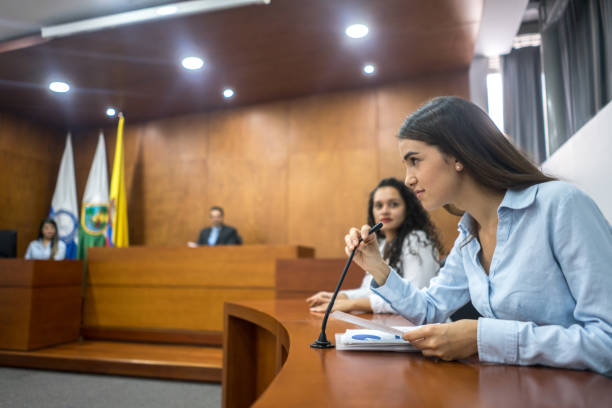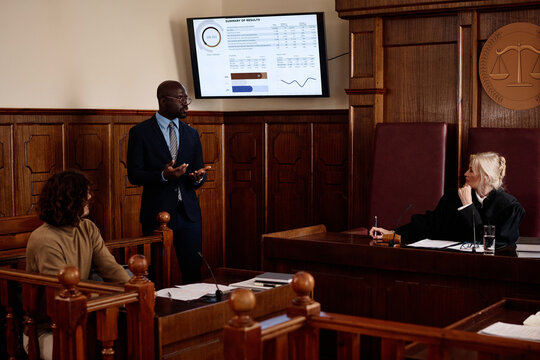Navigating Complicated Instances: How to Establish Reliable Trial Presentations for Optimal Results
Navigating Complicated Instances: How to Establish Reliable Trial Presentations for Optimal Results
Blog Article
Browsing the Intricacies of Test Presentations: Tips for Seamless Shipment and Engaging Arguments
In the realm of legal proceedings, the art of test discussion stands as a crucial factor of success. The complexities fundamental in test presentations require a delicate equilibrium of strategy, ability, and skill.

Comprehending Trial Purposes
To effectively browse a trial, it is crucial to have a clear understanding of the goals that require to be achieved. Before tipping into the courtroom, legal groups must specify their goals and preferred results. These purposes offer as leading principles throughout the trial, shaping approaches and influencing decision-making processes.
Understanding trial objectives entails a comprehensive analysis of the situation, legal precedents, and the customer's benefits. Trial Presentations. It needs a precise evaluation of the facts, identifying essential concerns, and preparing for potential obstacles. By establishing measurable and certain objectives, lawyers can tailor their presentations and disagreements to line up with the preferred outcomes
Additionally, a clear grip of trial objectives makes it possible for lawful groups to focus on evidence, witnesses, and lawful disagreements successfully. It enables the development of a meaningful story that resonates with the discretionary, reinforcing the general instance discussion.

Organizing Proof Properly
Having a clear understanding of trial goals lays the structure for arranging proof effectively in legal process - Trial Presentations. By lining up the discussion of proof with the desired results of the test, lawful teams can enhance their arguments and improve their persuasiveness. One crucial aspect of organizing evidence is classification. Grouping evidence based upon motifs or significance to specific legal components can aid streamline the presentation and make complex information a lot more absorbable for the judge or court.
Another crucial element in arranging evidence properly is developing a rational flow. Offering proof in a systematic and consecutive way can aid develop a compelling narrative that sustains the lawful arguments being made. Additionally, using aesthetic help such as timelines, charts, or charts can additionally enhance the organization of proof and aid in clearing up complicated relationships or series of occasions.
Additionally, making certain that all evidence offered is pertinent and acceptable to the instance is vital. Unimportant or inadmissible evidence can diminish the strength of the disagreement and possibly harm the integrity of today party. A precise review and selection procedure should be taken on to consist of just the most impactful and lawfully sound proof in the trial presentation.
Crafting Persuasive Stories
Crafting engaging narratives plays a crucial function in offering persuasive debates throughout legal process. When creating a narrative for a trial presentation, it is necessary to develop a clear storyline that highlights key factors and links them in a coherent fashion. By weaving together evidence, testament, and lawful disagreements right into a natural and persuasive story, lawful specialists can properly promote for their customers and boost the probability of a favorable outcome in the court.
Understanding Visual Aids
Effective use visual aids is essential to improving the impact and clarity of test presentations. Aesthetic aids, when utilized tactically, have the power to simplify intricate information, enhance bottom lines, and leave an enduring impression on the judge and court. To grasp aesthetic help in trial discussions, it is important to ensure that they are clear, succinct, and see here relevant to the disagreements being made.
When incorporating aesthetic help, such as charts, timelines, photos, or graphs, right into a test presentation, it is necessary to maintain them visually appealing yet expert. The visuals ought to complement the spoken debates, supplying an aesthetic depiction of the information being reviewed without frustrating the audience with unnecessary information.
Additionally, exercising with the aesthetic aids ahead of time is necessary to make certain a smooth distribution during the trial. Familiarizing oneself with the material, shifts, and timings of each aesthetic aid can assist maintain the flow of the discussion and stop technological problems that might arise.
Delivering Impactful Closing Disagreements
A compelling closing debate offers as the culmination of a trial presentation, enveloping the core story and encouraging the court and court in the direction of a beneficial choice. Begin by outlining the major disagreements that sustain your client's placement, highlighting why the proof provided throughout the test supports your story.
In addition, integrating psychological appeal can further strengthen your closing argument. Ultimately, a well-crafted closing argument should leave a lasting perception, engaging the court and jury to rule in your client's favor.
Final Thought
In verdict, grasping trial discussions entails understanding objectives, organizing proof, crafting narratives, utilizing visual aids, and providing impactful closing arguments. By carrying out these techniques effectively, legal representatives can present their case effortlessly and published here make engaging debates in the court. It is crucial to browse the intricacies of test discussions with accuracy and site link skill to achieve success in lawful procedures.
By straightening the discussion of proof with the preferred outcomes of the test, legal teams can enhance their debates and improve their persuasiveness (Trial Presentations). To master visual aids in trial discussions, it is essential to make sure that they are clear, succinct, and appropriate to the debates being made
An engaging closing argument serves as the conclusion of a trial presentation, enveloping the core narrative and persuading the judge and court towards a beneficial decision. Begin by detailing the major arguments that sustain your customer's setting, stressing why the evidence presented throughout the test supports your story.In conclusion, mastering test presentations includes understanding purposes, arranging proof, crafting narratives, making use of visual aids, and providing impactful closing disagreements.
Report this page